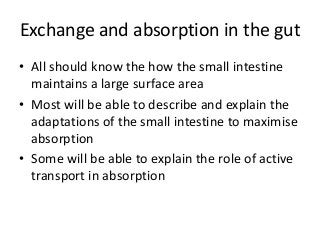
Mrs Abrey Lesson 11 exchange in the gut
- 1. Exchange and absorption in the gut • All should know the how the small intestine maintains a large surface area • Most will be able to describe and explain the adaptations of the small intestine to maximise absorption • Some will be able to explain the role of active transport in absorption
- 2. Stick me in label the structures and add function if you can!
- 3. Exchange and absorption in the gut The small intestine is the site of absorption of useful molecules of digested food. These molecules must pass across the lining of the small intestine and enter the blood stream. Their destinations are the cells of the body. The absorption process must be very efficient to keep up with the high demand of chemicals needed by our cells.
- 4. Exchange and absorption in the gut • What molecules are absorbed? • How do you think they are absorbed? • Can you think of any features the small intestine must have in order to be able to do this? • Watch video – Recap digestive system and capsule endoscopy
- 6. Maximising the surface area The result of this folding means that the surface area of the lining of the small intestine is enormous! Direction of Food Epithelium of small intestine This increases the number of places where small soluble food molecules can pass across and move into the blood.
- 7. Exchange and absorption in the gut • Label and explain the adaptations of the small intestine
- 8. How are the villi adapted • Villi have rich blood supply which provides steep concentration gradient between the gut and the blood. • Short diffusion distances between the contents of the gut and the blood (thin wall) • All surfaces moist and all substances dissolved in water. • Each villus covered with microvilli which further increase the surface area for diffusion.
- 9. Exchange and absorption in the gut Coeliac 1. What has happened to the villi of the person with coeliac disease? 2. What do you think Healthy the consequences are going to be? 3. What is going to happen if that person stops eating wheat?